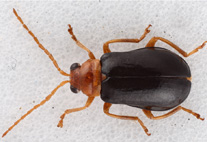Abstract
Two new mayfly genera and species from the Triassic deposits of the Pałęgi area (southeast Poland) are described. This is the first description of aquatic insects from the Pałęgi locality. Triassolitophlebia palegica gen. et sp. nov. (Litophlebiidae) is established on the basis of an isolated forewing. This is the first finding of this family in the Northern Hemisphere, known previously only from the Molteno Formation (South Africa). This is also the first mayfly family from the Triassic which has been found in both Hemispheres, providing additional evidence of the presumed similarity of aquatic insect faunas in the Southern and Northern Hemispheres during the Triassic. The consistent wing venation of ancient mayflies with homonomous wings could be evidence that they originated from the same ancestor. The second new mayfly, Palegonympha triassica gen. et sp. nov. (Vogesonymphidae), is described on the basis of a single fossil nymph (imprint of the exuviae) and indicates the similarity of the Pałęgi arthropod assemblage to that described from the Middle Triassic of France. The presence of a mayfly nymph in the last instar stage suggests not only that the Pałęgi deposit represents a fluvial environment with well-oxygenated and limpid water but also that these conditions lasted long enough to allow for such development.

